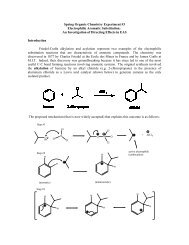Geometrical Aspects of Folding, Origami What geometry terms or ...
Geometrical Aspects of Folding, Origami What geometry terms or ...
Geometrical Aspects of Folding, Origami What geometry terms or ...
You also want an ePaper? Increase the reach of your titles
YUMPU automatically turns print PDFs into web optimized ePapers that Google loves.
<strong>Geometrical</strong> <strong>Aspects</strong> <strong>of</strong> <strong>Folding</strong>, <strong>Origami</strong><strong>What</strong> <strong>geometry</strong> <strong>terms</strong> <strong>or</strong> examples did you notice while folding?point: “a specific location” (no length <strong>or</strong> width, dimension zero)line: “an unending length”, a breadthless length (Euclid), a widthless lengthAfter Euclid’s w<strong>or</strong>k had been studied and analyzed, mathematicians decided it isimpossible to define all <strong>terms</strong> without res<strong>or</strong>ting to infinite regress. Point and line areconsidered to be <strong>of</strong>ficially not defined, just undefined w<strong>or</strong>ds used without definition.The basic building blocks. You need to start somewhere.angles: right (90 degrees), acute (less than 90 degrees), obtuse (90 to 180 degrees), 45degreesparallel lines have equal distance between them, will never intersectperpendicular lines f<strong>or</strong>m equal angles (90 degree right angles)square: 4 equal sides and 4 right angles)rectangle: opposite sides are equal and 4 right angles – note all 4 sides do not need to beequal lengthparallelogram: opposite sides equal length and opposite angles are equal – note that all 4angles do not need to be equal. A rectangle that gets pushed over to the side is aparallelogram.Every square is a rectangle. True <strong>or</strong> False: If it is a square, then it is a rectangle. (True)Not every rectangle is a square. True <strong>or</strong> False: If it is a rectangle, then it is a square.(False)rhombus: 4 equal sides and opposite angles are equal – note that all 4 angles do not needto be equal. If you take a square and push it over, then you have a rhombus.quadrilateral: any 4 sided polygontriangle: any 3 sided polygonequilateral triangle: 3 sides <strong>of</strong> equal lengthisosceles triangle: 2 sides <strong>of</strong> equal lengthscalene triangle: no sides <strong>of</strong> equal length(over)
Motions:Flip <strong>or</strong> Reflect (pick up <strong>of</strong>f table and turn over)Rotate (keep flat on the table and turn like the hands <strong>of</strong> a clockConvex: Fold edges “up”. The fold is away from you, and edges are toward you. Auth<strong>or</strong>Paul Jackson calls this a valley fold.)Concave: Fold edges “back”. The fold comes toward you, and you move the edges <strong>of</strong>the paper away from you. Auth<strong>or</strong> Paul Jackson calls this a mountain fold.Line <strong>of</strong> Symmetry: both parts look identical on either side <strong>of</strong> this lineHow to make a square piece <strong>of</strong> paper by folding:Method 1: Fold one c<strong>or</strong>ner down (keep edges even) until you have two isosceles 45-45-90 triangles on top <strong>of</strong> each other sharing the diagonal hypotenuse. Cut <strong>or</strong> nail crease andgently tear <strong>of</strong>f the extra strip.<strong>or</strong>Method 2: Use a second piece <strong>of</strong> paper to mark the sh<strong>or</strong>t side along the length <strong>of</strong> the longside. Crease. Cut <strong>or</strong> remove extra strip.
















